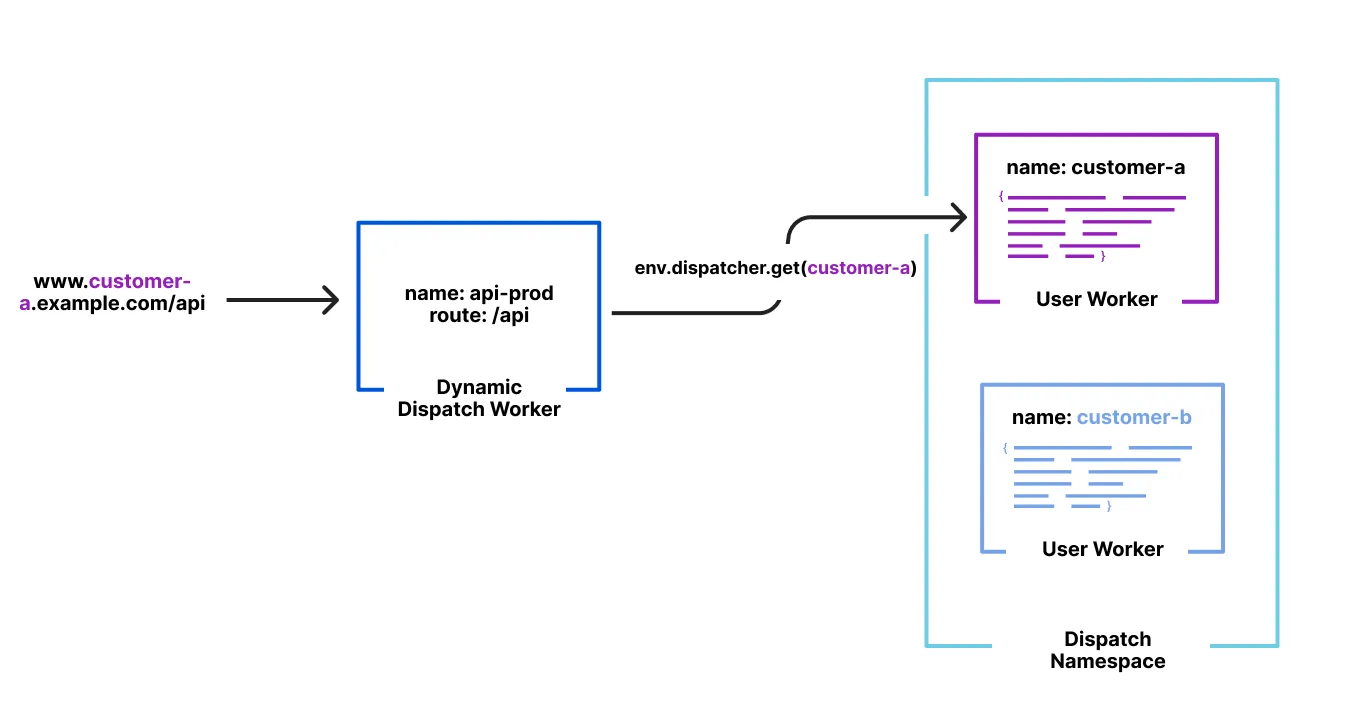How Workers for Platforms works
Workers for Platforms is built on top of Cloudflare Workers. The same security and performance models used by Workers apply to applications that use Workers for Platforms.
The Workers configuration API was initially built around managing a relatively small number of Workers on each account. This leads to some difficulties when using Workers as a platform for your own users, including:
- Frequently needing to increase script limits.
- Adding an ever-increasing number of routes.
- Managing logic in a central place if your own logic is supposed to come before your customers' logic.
Workers for Platforms extends the capabilities of Workers for SaaS businesses that want to deploy Worker scripts on behalf of their customers or that want to let their users write Worker scripts directly.
Workers for Platforms introduces a new architecture model as outlined on this page.
A dispatch namespace is composed of a collection of user Workers. With dispatch namespaces, a dynamic dispatch Worker can be used to call any user Worker in a namespace.
A dynamic dispatch Worker is written by Cloudflare’s platform customers to run their own logic before dispatching (routing) the request to user Workers. In addition to routing, it can be used to run authentication, create boilerplate functions and sanitize responses.
The dynamic dispatch Worker calls user Workers from the dispatch namespace and executes them. The dynamic dispatch Worker is configured with a dispatch namespace binding. The binding is the entrypoint for all requests to user Workers.
User Workers are written by your end users (end developers). End developers deploy user Workers to script automated actions, create integrations or modify response payloads to return custom content.
Below you will find an example request lifecycle in the Workers for Platforms architecture.

In the above diagram:
- Request for
customer-a.example.com/apiwill first hit the dynamic dispatch Worker (api-prod). - The dispatcher (
env.dispatcher.get(customer-a)) configured in your dynamic dispatch Worker code will handle routing logic to user Workers. - The subdomain (
customer-a.example.com) of the incoming request is used to route to the user Worker with the same name (customer-a).
Both Workers for Platforms and Service bindings enable Worker-to-Worker communication.
Service bindings explicitly link two Workers together. They are meant for use cases where you know exactly which Workers need to communicate with each other. Service bindings do not work in the Workers for Platforms model because user Workers are uploaded as needed by your end users.
In the Workers for Platforms model, a dynamic dispatch Worker can be used to call any user Worker (similar to how Service bindings work) in a dispatch namespace but without needing to explicitly pre-define the relationship.
Service bindings and Workers for Platforms can be used simultaneously when building applications.
Workers for Platforms user Workers have access to namespaced cache through the cache API. Namespaced cache is isolated across user Workers. For isolation, caches.default is disabled for namespaced scripts.
To learn more about the cache, refer to How the cache Works.
Was this helpful?
- Resources
- API
- New to Cloudflare?
- Products
- Sponsorships
- Open Source
- Support
- Help Center
- System Status
- Compliance
- GDPR
- Company
- cloudflare.com
- Our team
- Careers
- 2025 Cloudflare, Inc.
- Privacy Policy
- Terms of Use
- Report Security Issues
- Trademark